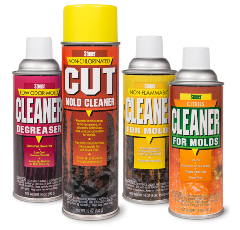Mold Cleaning: Do's and Dont's
By: The Stoner Molding Solutions Experts
Ask 10 molders how, and when they clean their tools, and you will probably receive 10 different answers. Much of the time, mold cleaning depends on the parts being run, the types of tools being used, and the molder's own process. But there are a few general guidelines that will help keep this part of your preventive maintenance program from causing unnecessary downtime. Regular cleaning promotes not only better part quality but also fewer interruptions to production. Here are some quick guidelines:
Develop a cleaning schedule:
As a rule of thumb, molds should be cleaned prior to being put into production, and again before going into storage. In any event, creating a systematic schedule for cleaning can prevent costly downtime. While a tool is in production, operators should keep an eye on buildup, preventing it before it becomes a problem. A can of cleaner kept near the machine allows operators to clean the tool on the spot if buildup occurs.
Beware of the trade-offs:
When choosing mold cleaners, fast evaporating mold cleaners are powerful, don't require a lot of scrubbing, and get into the nooks and crannies of the tool. These cleaners won't leave marks from scrubbing or residue on the part. However, cleaners that are not fast acting can lead to mold or part spotting. Still some molders prefer a slower evaporating cleaner (i.e., citrusbased) that allows them to apply the product, wait to let it dissolve contaminants, and then wipe down the tool later.
Keep an eye on part quality:
Some mold cleaners can leave residue on the mold that will affect part quality down the road if they evaporate too slowly. This can leave marks on the part that degrades aesthetic quality, and possibly functional performance. Make sure that all of the
cleaner has evaporated prior to putting a tool back into production.
Don't neglect rust proofing:
As most molders and OEMs are keenly aware, the price of molds can be astronomical. Therefore, it makes sense to apply a rust preventive product, especially during humid months. Doing this before sending a tool to storage creates a barrier between the tool and the elements, which helps to minimize unnecessary cleaning.
Watch for resin build up:
During the course of molding, some resins may produce buildup on the tool more readily than others. Nylon, for example, has a reputation for fast buildup. Also, if production must be halted because parts begin to show specks of degraded resin, it is a good idea to clean the tool.
Stoner Molding Solutions is a leading supplier of industrial mold release agents in the polyurethane, plastic, rubber and composites fields, based in Quarryville, Pa. For more information, call +1-888-303-5198 (US) or +1-717-500-3512 (International).
